Actually, I would like to tell you about the prerequisites for what and, most importantly, how to automate in the clinic. Because then there was only 1C, and, as you know, the letter "U" in the name of this software is responsible for convenience. But to understand why it is so important to do the same treatment plans with imaging in three minutes, you need to tell a little about how dentistry generally works. And where, how and on what it really earns.
It was - it is

Anamnesis
The clinic in Ulyanovsk (a city with a population of about 620 thousand people at that time) was run by a dentist and a technician who were well versed in equipment and procurement. The premise was extremely unfortunate, it was located on the 4th line: from the avenue to the street, from there to the alley, turn there again and to the building with a frightening facade from the 90s. The building belonged to the founder, there was previously an office there. The backbone company changed its type of activity, the premises were partially vacated. The sale did not seem economically feasible, so it was decided not just to lease it, but to “populate” with promising private ones. One of such projects is this very clinic.
At the time the events began, it had already existed for three years under the guidance of a practicing chief physician. The medical unit was in almost perfect order. However, the composition of the staff was imbalanced towards the provision of emergency care and with very little focus on systemic treatment and implantation. The surgeon combined and came only three or four times a week in the evenings, mainly to extract teeth from patients languishing with impatience.
Financial statements - constant fluctuations just below the break-even point. The proceeds were enough for salaries, consumables and rent, but not enough for development (and there was no way to replenish the depreciation of expensive equipment). The advertising budget was small and was used haphazardly in the spirit of "Well, I probably need to order a billboard - let's order for a month." The loyalty program included 15% discounts for students and pensioners. About 90% of the client base were residents of the microdistrict, and about 10% were regular patients of doctors, "worked out" at previous jobs.
The clinic was perceived on the specialist market as one of the best in the city in terms of equipment for therapeutic care, on the one hand, and as an economy class on the edge of the microdistrict with no special advantages, except for prices for the bulk of patients. Nine half-load chairs, no implantation.
Moving from discounter to mid-range
It immediately became clear that the growth potential is huge. The technical support of the clinic would make it possible to immediately enter the top 3 clinics in the city without additional training and even lead it. The professional staff already at that time was one of the best in the region (taking into account that there is no medical institute in Ulyanovsk, and only later the faculty of dentistry appeared). At the same time, due to the lack of marketing and financial planning skills, the clinic was engaged in low-paid work and took far from the volume of patients that should have been expected. The clear drawback was the very poor accessibility of the building. It never even occurred to anyone that in such a place in the district where grandmothers get their stash out of a plastic bag, premium services could be provided. And everything was for this.
Moreover, no one really knew about the clinic. All the same frankly bad place did not allow the signboard to become familiar: it was impossible to notice the point from the passable streets. It was possible to find out about her only at the moment when a tooth ached, and not just driving by to work or to a bar.
The first step was decided to raise the margins of services and focus on the middle (BC, BC +) class. Three processes were launched simultaneously:
- We released our own glossy edition.
- We started working with search engine promotion.
- They began to conduct conversations with work collectives.
The "magazine" was needed to explain what can be done with teeth in general and what this particular clinic can do and what others cannot. The main articles were about those things that are not included in the compulsory medical insurance - what kind of dentures are there, why, how to restore teeth, about aesthetics and beauty. That is, it is something like teaching clients about what happens in the world and why it is best to do this on the equipment of this particular clinic (the most advanced for the city). More precisely, what is the difference with other technical implementations of similar services. At that time, the entire city was prosthetic with cermets (already obsolete at that time, but still very familiar to patients), no one had a panoramic X-ray, and so on. That is, the opportunities to stand out in terms of equipment were very good. The "magazine" was also laid out at partners - in the right car services,the right cosmetic clinics and other premium segment habitats.
SEO was already an important channel (even more important than PPC advertising), but was still underestimated by others in Ulyanovsk. And then it was much easier to go into the search and it was possible to gain a foothold there for a long time. That is, it was a one-time investment that provided quite a few patients for the next three quarters. For this, the site was completely redesigned. Live photos from the clinic appeared, a detailed description of the services.
Conversations with work teams are an opportunity to convince 50-60 people at once personally. Everyone has problems with teeth, it is only important to show where you can do it beautifully and safely. And so far - relatively cheap. In parallel, work was underway to expand insurance coverage, which allowed us to get more clients from other areas.
Loss of old clients, arrival of new ones
Increase in prices by 25% in half-year gives rise to 56% per year. If the old customers somehow endured the first wave (albeit with grumbling), then the loss of existing customers began and their gradual replacement with new ones began. Considering that the entire LTV of the old economy client was covered by the only first visit of the new client from the middle + category, financially it went smoothly. At the same time, the mechanics of the loyalty program changed (order was restored, discounts decreased), part-time employees were replaced by full-time specialists, profits were reinvested and equipment was additionally purchased for a future transition to the premium segment. The level of medicine began to rise rapidly, and this allowed, in turn, to promote the HR brand, doctors began to migrate to the clinic.
A new working regime was needed: pensioners came in the afternoon, but businessmen and officials already wanted in the evening or on weekends. At first, the clinic occupied an additional niche of evening visits, and after another two years it was already working without weekends and holidays 365 days a year. On Sunday evening, it was easy to gather a council of all specialists. The new mode of operation made it possible to take those clients who could not get such a service anywhere else. It was a completely separate layer of people in the spirit of “I see the goal, I see no obstacles”, who reacted very calmly to the numbers in the treatment plan.
The team of strong therapists has been reinforced by periodontists. More precisely, before that there was one specialist, but he carried out the cleaning: in fact, he was a highly paid hygienist. Hygienists appeared separate, and doctors were instructed not to perform cleaning on their own.
The biggest change in the transition from the middle segment to the higher segment was the integrated approach to treatment. It was here that the development of solutions for automating these processes began: perhaps the IT system became the basis of the clinic's competitive advantage:
- : — . , , - . — . , .
- -, . , , . - . — , . VIP, - .
- , . VIP- . : «, . ?». - « ?» . , — .
- . , , . , ( , ), . .
- . - . , «» «» .
I had to invite doctors from other cities for training. It is one thing to remove price negotiations from the therapist in order not to disturb his fragile mental balance, and another to resolve the questions “Why CT? I worked without it for how many years. " Nevertheless, when almost a year later it was possible to reduce the number of complications in a month from about 3% to seven cases per month by 30 doctors - it became obvious that many technologies like channel isolation are still needed and in demand. Patients also understood this thanks to the educational program in the same glossy magazine and social networks.
Social networks were first about cats and teeth, and then became news in dentistry. They posted everything in a row, but as the database grew, they became more serious, and patients waited for more and more detailed descriptions of procedures and illustrative examples of successful cases. It was important to be the first to take the place of the “familiar dentist in contacts”, because no one has actively promoted on VKontakte and other social networks. In a few months, they gained eight thousand live VK subscribers. As it turned out, many did not subscribe to the second clinic, even if its content was broader and more relevant.
Upgrade to premium +
So, by the end of 2013, the clinic had all the necessary equipment, processes for accompanying clients were put in place (but the processes of coordinating the treatment plan were not yet fully developed), search engine promotion and social networks began. In 2014, the clinic was re-equipped, introduced a new schedule of three doctors per chair and extended the working hours until 22:00, filled the weekend. A digital agency was created from the promotion team, which began selling services on the market, including to other clinics. Anesthesia appeared, data from the X-ray room immediately fell into the offices in electronic form. The building ended in 2015. The last neighbors were not ready to sell the premises, and the available 600 squares were occupied. We began to think about the greater intensity of what exists.
It was at this moment that the call center began to develop very actively and treatment coordinators became a dedicated role. At first they were administrators, then only one for VIP clients, then there were four of them. The administrator knew each of his patients by sight, had a communication plan, personally met at the clinic and accompanied. If the patient was treated by a charismatic doctor, then the coordinator simply did not shine. If there was a dialogue in the spirit of "good-evil", then the coordinator told in detail what the experienced professional muttered. And if the doctor had amazing manual skills, but almost zero communication skills, the coordinator took care of everything. The doctor nodded.
The automation of the processes of both contacting clients and the preparation and approval of treatment plans has appeared. We removed all unnecessary repeated appointments that did not bring money, began to draw up plans without “cutting corners” and skipping steps (which some doctors were inclined to do), and focused on repeated planned appointments. Between 88% and 92% of the techniques were repeated. They all had an intention to sell the idea of complete dental rehabilitation: an even row of healthy teeth in order to comfortably communicate with the opposite sex, chew comfortably, and feel expensive. Clients appeared "in zirconium from ear to ear", about whom one could forget for seven years, even if the patient did not brush his teeth, their LTV 2.5-3 million rubles. Businessmen looked at beautiful and understandable treatment plans with a rationale for each step and a clear breakdown of the estimate and understoodwhat exactly are they paying for. In general, in the premium segment, it is not the price itself that is important, but its validity: a person as a whole understands the price of money and is not ready to part with it if the same can be found more profitable in another clinic. The task was to show the uniqueness by reducing the number of complications, more modern technologies and approach. The coordinators coped with this, the patients silently signed contracts. In cases where the patient himself did not give money (father of a smiling daughter, husband of a wife with a model appearance, and so on), such visual plans also served as a very clear justification for spending. No other verbal explanation from other clinics could compete with a clear and understandable color document on expensive paper, where everything was detailed exactly as the VIP client expected. After their successful treatment, wives began to bring their husbands "on the lasso".New teeth were given to the closest friends for their birthday.
Here are examples of plans from those years, they almost completely migrated into the product that is being sold now:
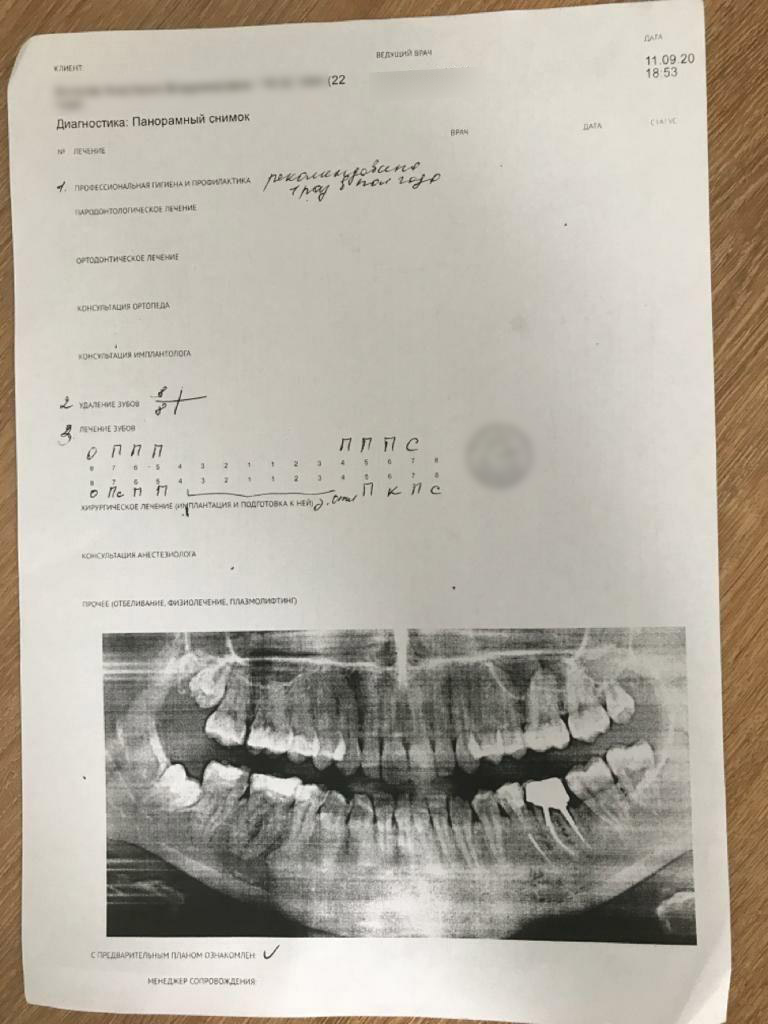
At that moment, CRM was kept in granary books, 1C was inconvenient for this, although it contained all financial records. When the first full-fledged program appeared, it became easier for administrators and others. The cashier admins danced most of all when they realized that instead of manually typing receipts from handwritten receipts at the reception, you can get ready-made files directly from the doctor.
Dear people began to call and report:
- Great, director. Well done, of course, but you are *****. I have six children, and each one receives a separate call.
We have developed a “caring doctor” process, when calls are still automated and are hammered by reminders from administrators and coordinators to the result, but only the most important reasons and at the right moments are selected, taking into account all the details of the family history. Calls have become pinpoint, pleasant and inviting.
This is how the scheduling of appointments now looks like:
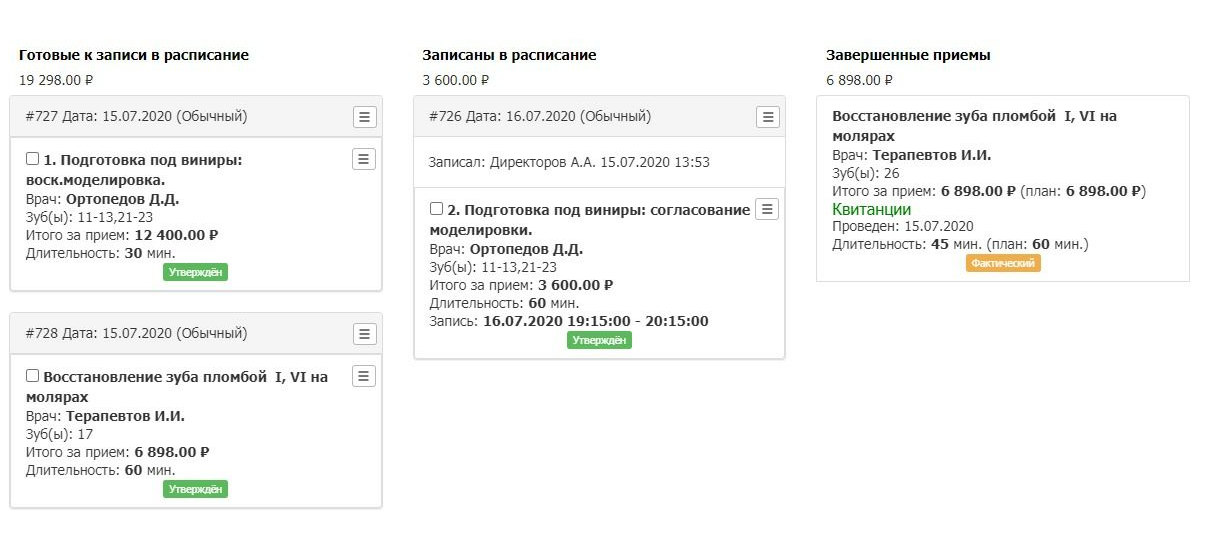
These are several options for treatment plans in the system:
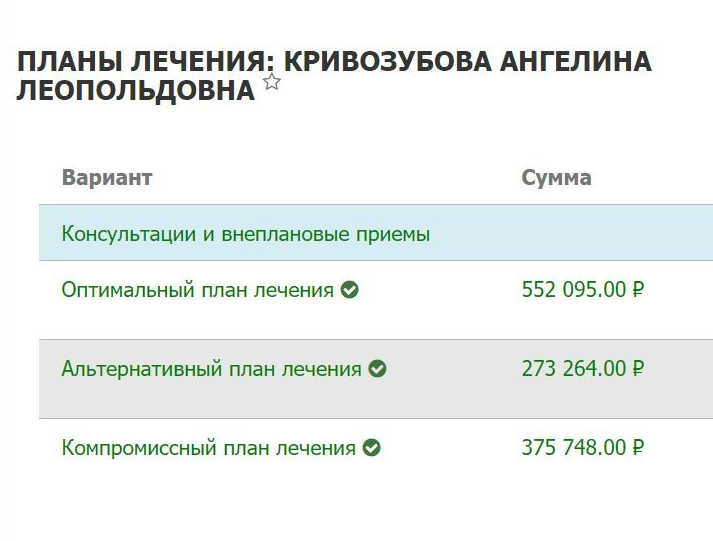
Comprehensive treatment plan, which we print out for the patient:
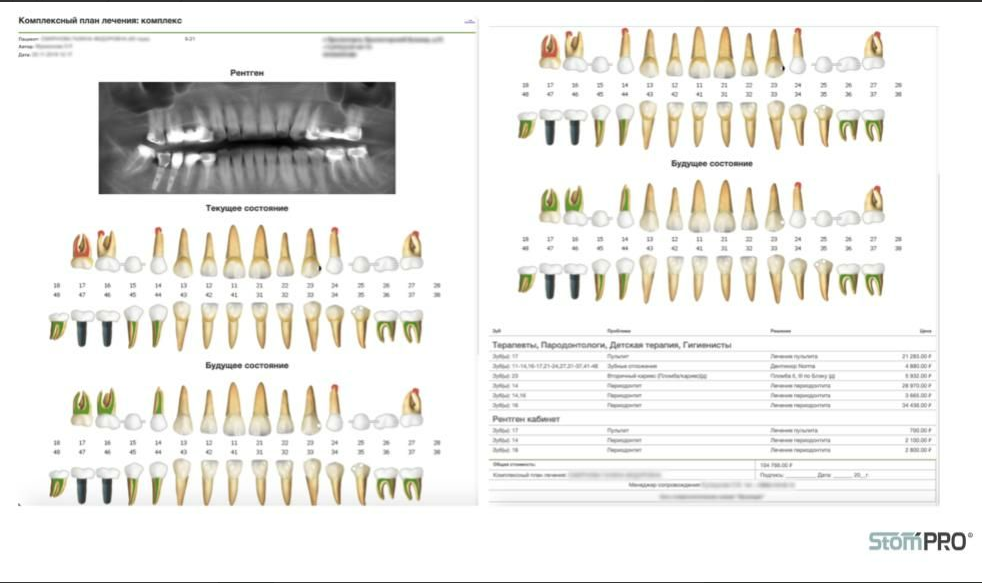
In detail:
1. We show the patient the state now: X-ray, photo protocol + dental formula, where all plaques, gum inflammation, lost teeth, caries, etc. and then: no plaque, no inflammation, implant / crown.
And so in three versions. Each treatment plan clearly shows what will change.
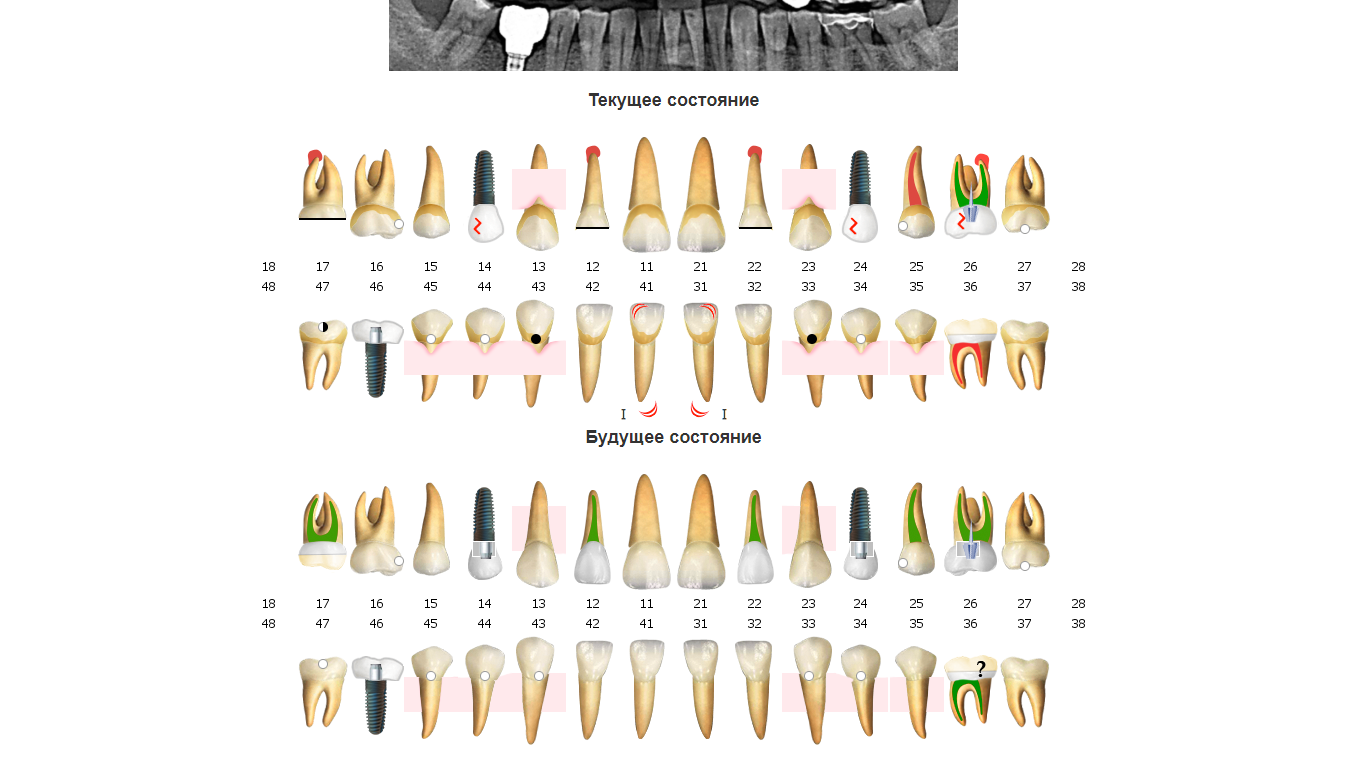
If you need related specialists in the same technique or in succession in several, it is easy to mark them:
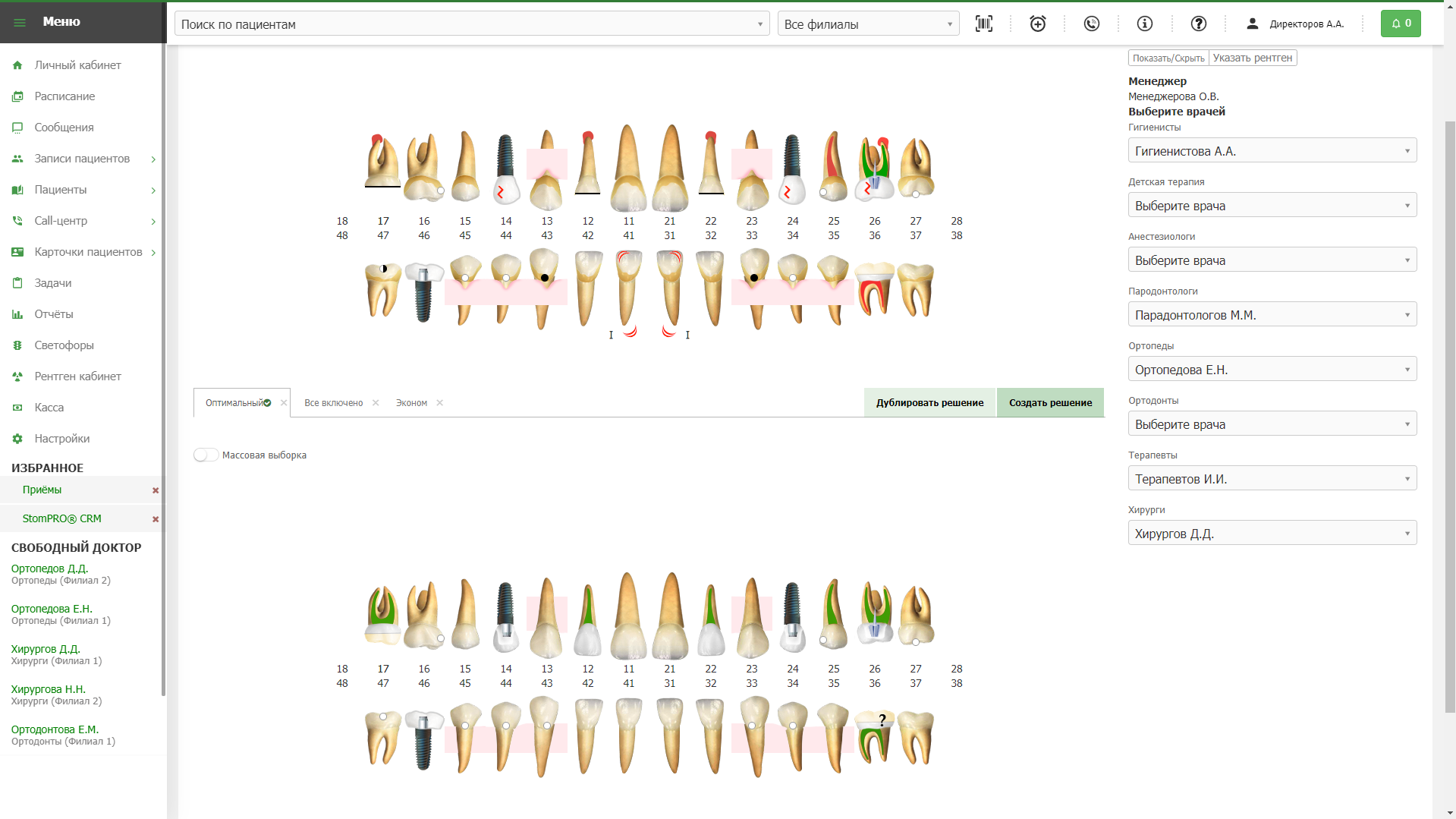
2. It is obligatory for each plan to be given an explanation of the scope of work and specialists:
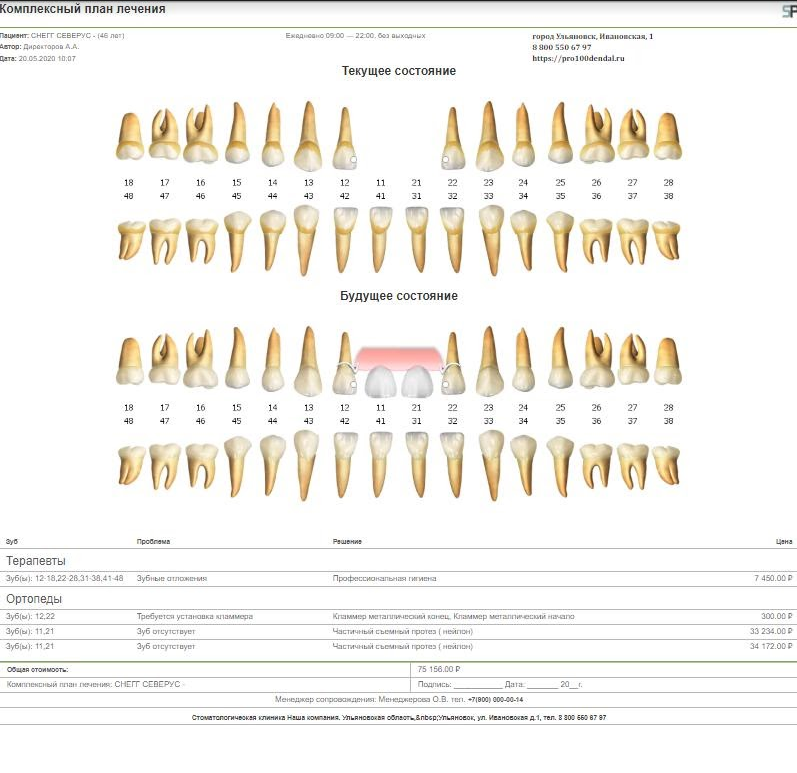
This is how the explanations look like: reception - problem - solution. The price is set or not set automatically, depending on the settings.
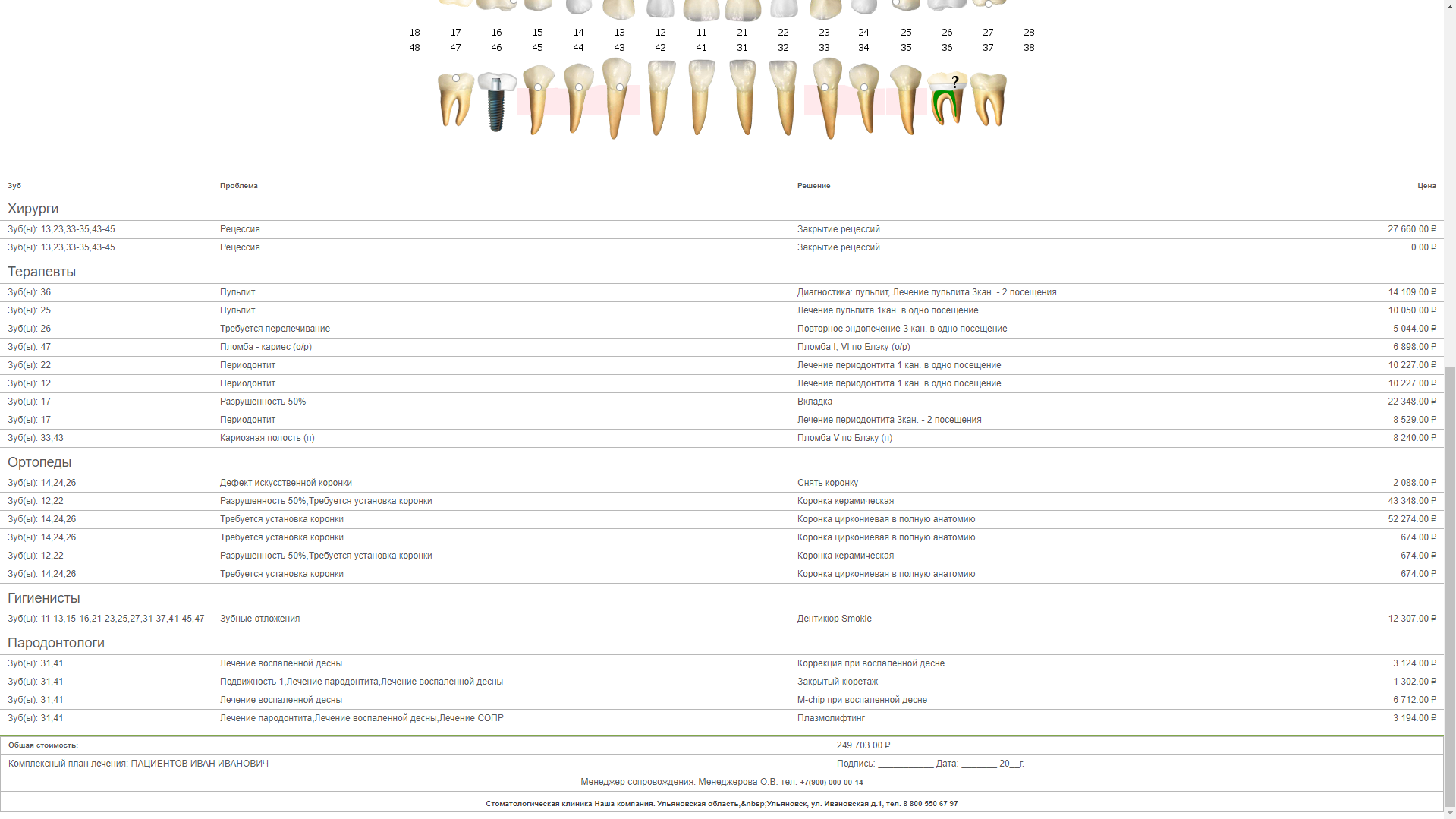
We introduced a quota for metal structures: at first it was 50%, then it was completely removed from the price list, including for insurance. According to the CEREC counter, the progress was as follows: 100 structures in the first year, about a thousand in the second, 23 thousand in the third, and in the fourth year there were two devices and two major overhauls were needed. The specialist in the laboratory had a test device under load, it had 25 thousand on the counter, and the specialist believed that it never happens again. He just worked only eight hours a day, rookie. The clinic had 56,000 restorations.
At the same time, such things as a rubber dam and other protocols became mandatory, which were considered the standard in the United States, and their absence was referred to as punitive medicine.
In 2016, we went to prices higher than 40% than in any other clinic in the city and stopped the increase. All the necessary specialists on this side of the river worked in the clinic. We have brought automation to mind. Not a single program in the country and in the world makes instant visualization of complex treatment plans, born during the reception. This continued to be a huge plus for the clinic, and no one could repeat it. The built-in CRM could serve the call center and administrators, everything went conveniently and orderly through the processes without unnecessary annoying actions. Electronic filling out of the cards saved time and made doctors' work easier. Checks - a couple of clicks without collecting waste paper around the clinic. The head doctor, who only three years ago trusted only paper, checked the maps on the veranda in the country in a comfortable armchair with herbal tea.Treatment plans for insured patients were collected exactly from the manipulations of the insurance program and were not edited (the patient could purchase additional services at his own expense).
It was then that it became clear that the main business is not so much the clinic itself as the sale of this automation core to other dental projects in Russia and the world. Actually, this is where the history of one clinic ends - and this is how the StomPRO dental control panel appeared. All modules, one way or another, have passed the baptism of fire in practice with living patients, doctors and administrators and have been tested by dozens of clinics in Russia and the CIS. Here you can see what happened.